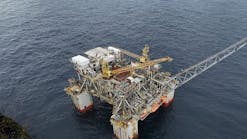Equinor to modify Oseberg infrastructure to increase gas production
Equinor Energy AS and Oseberg license partners will invest NOK 10 billion in infrastructure upgrades to increase gas production and reduce CO2 emissions from the North Sea field. A plan was approved by the Ministry of Petroleum and Energy Dec. 1.
The plan calls for two new compressors to be installed on Oseberg Field Center to lower process pressure on the platform and increase remaining recoverable gas and oil reserves by 54%. The modifications will make Oseberg Norway’s third largest gas field after Troll and Snøhvit, measured in remaining reserves, the company said in a release Dec. 1.
Oseberg production emissions will be decreased through partial electrification of the field center and Oseberg South platform (OGJ Online, Dec. 13, 2021). The modifications are expected to reduce CO2 emissions by about 320,000 tonnes/year, the operator said.
So far, Oseberg has produced about 80% oil and 20% gas, but gas production has outweighed oil production since 2021. Annual gas exports from Oseberg have increased to about 8 billion cu m (bcm) in 2022 from about 3 bcm up to 2018. Gas accounts for about 80% of remaining recoverable reserves. The field is expected to produce 100 bcm of gas between 2022 and 2040.
Primary contracts have been let to Aibel for new modules and upgrades to Oseberg and to Nexans for delivery and installation of the subsea cable. The project is expected to be complete in 2026.
Equinor is operator at Oseberg (49.3%) with partners Petoro AS (33.6%), TotalEnergies EP Norge AS (14.7%), and ConocoPhillips Skandinavia AS (2.4%).

Alex Procyk | Upstream Editor
Alex Procyk is Upstream Editor at Oil & Gas Journal. He has also served as a principal technical professional at Halliburton and as a completion engineer at ConocoPhillips. He holds a BS in chemistry (1987) from Kent State University and a PhD in chemistry (1992) from Carnegie Mellon University. He is a member of the Society of Petroleum Engineers (SPE).


